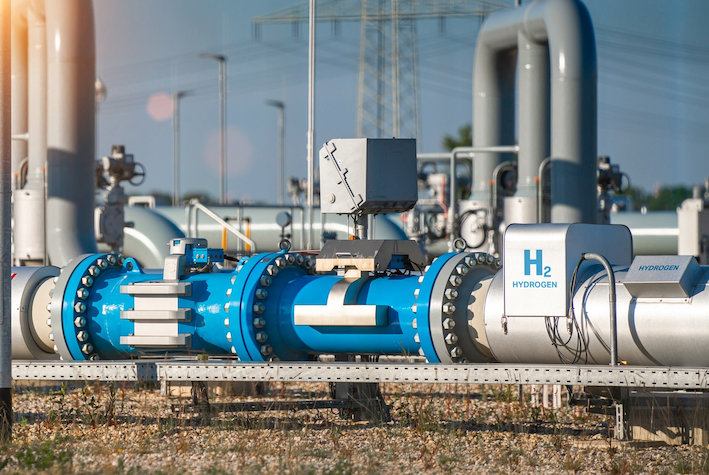The pressure on UK Government to publish their Hydrogen Strategy continues, as a fleet of Wrightbus hydrogen buses glides successfully along the Aberdeen roads without any CO2 emissions.
Several other cities are launching hydrogen bus fleets. Simultaneously, an increasing number of other emission-lowering hydrogen powered vehicles are entering operation, including cars, trains, boats and planes.
Meanwhile UK hydrogen-powered test homes are enjoying low emission warmth and cooking applications, as a mass influx of private sector investment in the broader green hydrogen sector continues, with new hydrogen technology start-ups being announced daily.
Gas companies such as Cadent have formed strategic alliances to push their own moves into clean hydrogen forwards. Ambitious plans for UK green hydrogen production plants are well underway, as infrastructure projects start to emerge at key points across the country.
Public awareness of hydrogen as a clean fuel alternative has risen dramatically.
It has taken a few years to rise up the industrial and political agenda, but the UK hydrogen revolution is now underway.
When the UK’s net-zero targets became legally binding the Climate Change Committee pushed hydrogen to the forefront of solutions for decarbonising the economy. Then there was the Ten Point Plan which saw increased funding for hydrogen (it featured in the majority of the ten points), as industry piled on pressure to roll-out the sector more rapidly.
Yet these early success stories are just the tip of the iceberg, as it won’t be until the Government release its Hydrogen Strategy that the bulk of private sector investment, bursting at the seams, will be let loose on the UK hydrogen economy.
The strategy required is a much needed plan to unlock this significant untapped private investment in hydrogen technologies, and hydrogen manufacturing across the country, driving growth and creating green jobs in the process. The hydrogen industry is predicted to be worth £2.5 trillion within then next 29 years, supporting 30 million green jobs along the way.
Countries who have already released and implemented their own Hydrogen Strategies include Canada, France, Japan, Australia, Norway, Germany, Portugal, Spain, Chile, and Finland, and the European Union. The UK has the private sector willing, the technological capabilities and the natural resources needed to swoop in and lead the way with hydrogen, but Government support, both for infrastructure and strategy, is the key to optimal success.
In their hydrogen roadmap report this year the UK Hydrogen and Fuel Cell Association, including heavyweights such as Rolls Royce, called for government to stop prioritising other industrial sectors over green hydrogen.
The Nuclear Industry Council (NIC) and Nuclear Industry Association (NIA) are calling for higher carbon pricing, and increased R&D funding, to establish new financing models to bring the cost of green hydrogen down in line with fossil-based hydrogen, which still accounts for 95% of global annual production.
Echoing the All-Party Parliamentary Group on Hydrogen, MPs on the Environmental Audit Committee (EAC) have also been critical of the Ten Point Plan saying it only provides short-term limited support, going on to say greater breadth and long term commitments are vital to the sector scaling up.
As the EU continue to rollout the European hydrogen sector within their rigorously planned Hydrogen Strategy, the pressure is on the UK to make sure it doesn’t lag behind in the race to be a competitive exporter.
The rewards for the UK economy, alongside reaching net zero, are simply too great to be allowed to go elsewhere. Especially as we still shudder at having missed the opportunities to get ahead in battery technology, and even more painfully the wind energy sector, which we could’ve dominated in.
Yet despite the lack of strategy, the slew of UK hydrogen projects continues to make the clean energy headlines.
2022 will see the first homes to use green hydrogen supplied through a gas grid opened in Fife. Meanwhile BEIS announced the ‘Gateshead 100% hydrogen homes’, with hydrogen-fuelled heating and cooking appliances funded by the Government. The hydrogen, like normal gas, can be stored in tanks on site.
Jaguar Land Rover are testing hydrogen fuel cell electric vehicles.
The NHS are trialling zero-emission hydrogen ambulances.
This year’s budget saw the successful application by British businesses to establish a Freeport East Hydrogen hub.
Wrightbus successfully launched the world’s first zero-emission hydrogen double-decker buses.
So it is well understood that Hydrogen is key to decarbonising the UK, boosting the economy with billions of pounds of shovel ready private investment, and creating thousands of much needed green jobs, as we emerge from lockdown, blinking into the Spring 2021 light.
But those same eyes are also focused intently on BEIS now, to deliver upon the long-awaited UK Hydrogen Strategy.






